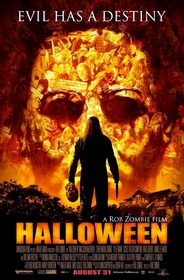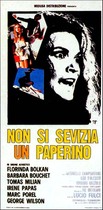Our editor-in-chief Nate Yapp is proud to have contributed to the new book Hidden Horror: A Celebration of 101 Underrated and Overlooked Fright Flicks, edited by Aaron Christensen. Another contributors include Anthony Timpone, B.J. Colangelo, Dave Alexander, Classic-Horror.com's own Robert C. Ring and John W. Bowen. Pick up a copy today from Amazon.com!
Halloween (2007)
It would be best to consider writer-director Rob Zombie's remake of John Carpenter's Halloween as a separate entity from its progenitor, allowing Zombie's film the space to create its own identity in the annals of horror. Unfortunately, Zombie can't appear to let go of the original, filling his film with references, duplicated shots and sequences, even as he tries to forge his own version of the tale. The result is equal parts Rob Zombie, Rob Zombie emulating John Carpenter, and Rob Zombie attempting to "fix" John Carpenter, a list which runs in order from what works best (although hardly perfectly) to what doesn't work at all.
The major addition Zombie makes to Halloween is that he spends the beginning of the film exploring who Michael Myers really is by looking at his life immediately before and after he committed the horrific murders that sent him to Smith's Grove Sanitarium. 10-year-old Michael (played by Daeg Faerch) lives in white trash hell. His stripper mother Deborah (Sheri Moon Zombie) is married to a handicapped asshole (William Forsythe) who utters strings of profanities instead of human conversation, while his sister Judith wears ridiculously tight clothes and struts like a streetwalker. Michael himself likes to kill his pet rats with a scalpel. The only decent member of the family is Laurie, who Michael affectionately calls "Boo", and that's only because she's an infant too young to swear. Every other word in the household is "f**k," be it from child or adult. The whole introductory sequence feels like half-baked leftovers from Zombie's previous two movies, House of 1000 Corpses and The Devil's Rejects, which also extoll the psycho-creating nature of being white trash in Middle America.
From here, we get a glimpse of Michael at school, where a bully taunts him with a newspaper advertisment that flaunts Deborah's talents. After school, Michael tracks down and beats the bully to death with a tree branch. This sequence is put together very well, starting with Michael stalking his prey while John Carpenter's original Halloween theme plays in the background. When Michael assaults the other boy, Zombie focuses not on the brutality of the violence -- although there is no escaping its brutality -- but on how little Michael reacts to the situation. It's chilling, and one hopes that if Zombie is going to focus on the story of Michael, that he will continue to maintain that chill.
He doesn't. First, Zombie gives us a sequence that intercuts a dejected Michael with his mother's poledancing routine, all set to "Love Hurts" by Nazareth. Yes, it does hurt -- it hurts the audience. Then Zombie launches into Michael's murder of Judith, the one that opens Carpenter's Halloween, but he throws in the stepfather and Judith's boyfriend for good measure. It's perfunctory, unthrilling nonsense, a flood of crimson just to have a flood of crimson. It's made more ridiculous by the fact that 10-year-old Michael is dressed in a clown-themed poncho wearing the classic Michael Myers mask while doing in his sister. Zombie only manages to emphasize how silly he looks, a dwarf-sized parody of an iconic horror image. Worse, the murder of the boyfriend is almost exactly the same as the murder of the bully from earlier, a move which takes the edge out of both sequences.
Despite a turbulent beginning, however, what follows is probably the best section of the film: Michael's incarceration at Smith's Grove Sanitarium. Here both child psychologist Samuel Loomis (Malcolm McDowell) and Michael's mother try to reach out to the boy. He responds well at first, claiming to have no memories of the murders. However, as time progresses, his mood grows darker, he speaks less, and he becomes more obsessed with the cardboard masks he creates and insists on wearing everywhere (to "hide my ugliness"). Although neither Moon Zombie nor McDowell give particularly strong performances here, this middle act works because Rob Zombie's writing makes it work. We believe the reality of the institution, we believe Michael's increasingly troublesome behavior, and we believe it when Michael murders a nurse without provocation. If only Zombie had stuck to the guns he was obviously sticking to here, his Halloween might have been a much better film.
Fifteen years later, a now-adult Michael (played by the hulking Tyler Mane) makes a bloodbath of an escape from Smith's Grove. This escape, like the Myers massacre before it, is an excuse to gorily do away with mostly unlikable characters without suspense or dramatic necessity. From here, Zombie shifts his film into a quick-paced remix of Carpenter's Halloween, where the same notes are hit -- Michael stalks Laurie Strode (Scout Taylor-Compton) and her friends after school, Loomis teams up with Sheriff Brackett (Brad Dourif) to find Michael, and Michael stabs or strangles Laurie's more sexually active friends -- but the effect is much diminished. Zombie is following the basic plot that Carpenter laid out, even repeating the death scenes, paying nothing more than lip service to Carpenter's style. He leaves out almost all semblance of character development and suspense-building, yet still expects shots filched directly from the 1978 film to have the same effect as they did 29 years ago. Zombie's interest isn't terror or tension -- it's carnage and, apparently, naked breasts, both of which come in the kind of abundance that dilute their enjoyability.
Additionally, certain sequences are expanded that shouldn't be expanded. In particular, I'm thinking of the final showdown between Laurie and Michael, which here takes place in the abandoned Myers place and plays like an extended Tom-and-Jerry cartoon. Laurie dashes into a hole in the wall (no kidding) and Michael busts his way through the wall, only to find that his prey is missing -- she's already dashed behind him. Later, she climbs to the attic, and Michael strikes at her from below, hitting every floorboard but the one that she is on. The action is repetitive and tedious, defusing whatever minor rapport that Zombie may have built with his audience via bloody carnage.
Halloween is replete with cameos from such cult/horror luminaries as Udo Kier, Bill Moseley, Tom Towles, Sybil Danning, Dee Wallace, Clint Howard, Sid Haig, Ken Foree, and The Monkees' Micky Dolenz. The constant cameos are cute, but they tend to turn Zombie's movie into a game of "Spot the B-Movie Actor," distracting from the meat of the movie. Most of these are good actors asked to do little more than parade in front of the camera and receive our recognition. Poor Udo Kier gets one brief scene that adds nothing to the movie. Only Danny Trejo, as a kind-hearted attendant at Smith's Grove, gets a chance to show off his acting chops; it's a welcome sight to see him succeed with such a well-written part.
The most difficult part to accept about this new Halloween is that Zombie thinks he's fixing problems with the original. He doesn't like that Michael Myers can drive in Carpenter's movie, so he doesn't drive here. Except that Smith's Grove is clearly in a different town than Haddonfield, which means Michael has to walk the entire way. Later, it's established that it takes ten minutes for a police car to get from downtown Haddonfield to the street where Laurie is babysitting, making Michael's ability to cover the distances he does in such short periods highly implausible. Also, Zombie doesn't like that Michael acquires his mask somewhat randomly in the original, so he establishes it as originally belonging to Michael's sister's boyfriend. Once Michael makes his way back to Haddonfield as an adult, he digs the mask and his bloody knife up out of the floorboards of his old house. Either he hid them there after he killed his sister (and then professionally refloored the room) or someone else did it (his mother, maybe) after Michael was hauled away, in which case Mikey has a supernatural ability to locate hidden latex.
Rob Zombie's Halloween is disappointing, if only because it's clear that the director is capable of a better film. Many of the changes he makes that are clear depatures -- like the expanded Smith's Grove sequence -- work well. The places where Zombie is more closely following Carpenter's blueprints work hardly at all, because they only serve to highlight Zombie's inability to be Carpenter. No director wants his film to simply remind others that it's not as good as someone else's, but that's what Zombie has done. As such, he's created an unattractive curiousity and, hopefully, a dire warning to anyone who tries to remake John Carpenter's classic in the future.








